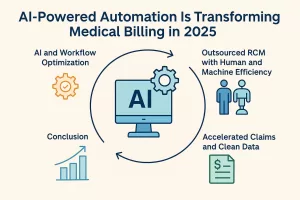Revenue cycle management is a crucial aspect of healthcare that ensures financial viability while maintaining patient care quality. Streamlining this process can seem daunting, but it doesn’t have to be. In this article, we’ll explore innovative and practical methods to simplify and enhance your revenue cycle management, making it more efficient and effective for your practice.
1. Embrace Technology for Automation
Utilizing advanced technologies like AI and machine learning can help automate several repetitive tasks, reducing errors and freeing up time for your staff.
By eliminating mundane processes through automation, revenue cycle management becomes more streamlined. For instance, automated billing systems can reduce human error and cut down processing times significantly. This innovation allows your staff to focus on enhancing patient care rather than getting lost in paperwork, effectively transforming the way your practice handles finances.
In addition, automation can provide real-time insights into coding and billing practices, enabling immediate corrective actions as needed. This means that practitioners can proactively address issues rather than reactively fixing mistakes. In essence, embracing technology becomes not just a trend but an essential strategy for optimizing your revenue cycle.
2. Enhance Data Management Practices
Properly managing and analyzing data helps you identify inefficiencies and make informed decisions that can streamline your revenue cycle.
It’s crucial to implement robust data management systems that not only store information securely but also allow for efficient retrieval and analysis. Empowering your team to access key performance indicators enables more strategic decision-making. For instance, evaluating and monitoring denial rates can pinpoint areas most in need of attention and improvement.
Moreover, adopting data visualization tools can translate complex data sets into user-friendly formats, allowing for data-driven discussions in team meetings. As insights flow, so too does the ability to make proactive adjustments to the revenue cycle management processes that drive your practice’s success.
3. Standardize Your Billing Processes
Creating a standardized billing process can minimize confusion, improve accuracy, and decrease the time it takes to collect payments.
Implementing a uniform approach to billing allows every staff member to be on the same page, which not only promotes consistency but also helps in identifying gaps. By delineating each step of the billing process clearly, from initial charge capture to final reconciliation, your team can operate more efficiently and effectively.
Regular audits of these processes can provide insights into any recurring issues that may arise, paving the way for ongoing refinement. Over time, as clarity builds within your system, you’ll likely see both staff satisfaction and patient experiences improve dramatically.
4. Optimize Patient Communication
Clear communication with patients concerning their billing and insurance can lead to quicker payments and better patient satisfaction.
Establishing transparent channels for discussions around financial responsibilities is key. Whether it’s through newsletters, phone calls, or digital messaging apps, keeping patients informed about the costs associated with treatments and the insurance process can demystify what they owe before treatment even begins.
Proactively addressing questions and concerns can foster trust, leading to a smoother collecting process. An informed patient is more likely to participate in their financial obligations, understanding the why behind their bills, which ultimately lessens confusion and boosts your collection rates.
5. Implement Continuous Staff Training
Regular training ensures that your staff is up-to-date on best practices and compliance regulations, reducing errors and enhancing efficiency.
Professional development opportunities should not only focus on formal regulations but also empower staff with soft skills necessary for effective communication. Regular workshops and training sessions can equally highlight new technologies and processes being employed in revenue cycle management.
Creating a learning culture where staff feel supported in enhancing their skills reinforces a sense of teamwork and efficiency. As they grow, so does the overall capability of your revenue cycle management efforts, translating into improved outcomes for your practice.
6. Utilize Analytics to Predict Trends
Employing analytics tools can help you predict financial trends, allowing for smarter strategic planning.
By assessing data patterns over time, you can identify fluctuations in patient volumes, seasonal trends, and even payer behaviors. This foresight enables your practice to adjust staffing levels, inventory, and marketing strategies proactively rather than reactively.
Working with reliable analytics software can create forecasts that guide financial planning and operational adjustments—transforming sporadic revenue into a steady stream. The potential of turning insights into actions can position your practice favorably in a competitive healthcare market.
7. Focus on Patient Financial Responsibility
Educating patients about their financial responsibilities up front can lead to higher collection rates and less confusion later on.
Providing transparent information regarding co-pays, deductibles, and out-of-pocket expenses before treatment can set expectations and pave the way for smoother interactions. Moreover, when patients understand the nuance of their financial responsibilities, they are far more likely to engage positively with the billing process.
Consider using simple infographics or clear charts that guide patients through their potential expenses. Simple resources like these go a long way in building patient engagement, leading to improved collection rates and stronger relationships.
8. Streamline Claims Management
Efficiently managing claims submissions and addressing denials promptly helps ensure that you receive payments faster.
Setting a systematic approach for claims that emphasizes swift submissions, consistent follow-ups, and resolution of denials can speed up your cash flow. Tracking claims through their lifecycle can help identify bottlenecks and design effective solutions to address them.
In addition to streamlining the process, educating your staff on the most common reasons for claim denials is paramount. By bridging this knowledge gap, you enhance the chances of first-pass claims acceptance, thereby significantly lowering the time and resources spent on resubmissions.
9. Foster Interdepartmental Collaboration
Encouraging collaboration between departments can identify revenue leakages and streamline processes across the board.
When billing, coding, and clinical teams work together, it creates a seamless flow of information that reduces errors and enhances patient care. Regular cross-departmental meetings can illuminate perspectives that drive innovations in revenue cycle approaches.
By promoting shared goals like minimizing denials or accelerating payment collections, collective problem-solving becomes the norm. A team-oriented approach nurtures communication and trust, effectively unleashing the potential for greater efficiency across your entire revenue cycle.
10. Adopt a Patient-Centric Approach
Putting patients’ needs at the center of your processes can enhance their experience, improving your practice’s reputation and revenue.
This idea revolves around not just seeing patients as numbers but understanding them as individuals with unique circumstances. Tailoring financial plans according to their situations can significantly impact their commitment to paying bills on time.
Consider offering flexible payment options or financial counseling to alleviate stress. Investing in patient-centric practices isn’t merely an ethical approach; it also tends to yield better revenue outcomes and promote long-term relationships with patients.
11. Invest in a Robust Revenue Cycle Management Software
Choosing the right revenue cycle management software can provide the frameworks needed for successful implementation of streamlined processes.
A comprehensive system should integrate seamlessly with existing applications, supporting areas from scheduling to billing and collections. This interconnectedness can provide clarity and enhance various operations involved in your revenue cycle.
Investing upfront may seem hefty, but the efficiency gained and errors reduced will amplify returns over time. A well-integrated system can elevate revenue cycle management into a smooth, predictable operation, propelling your practice forward.
12. Regularly Review and Adjust Strategies
Periodically evaluate your revenue cycle management strategies to ensure they remain effective and make adjustments as necessary.
Setting regular intervals for reviewing your processes keeps your revenue cycle responsive to market changes and internal demands. Ask the right questions: Are there emerging trends worth noting? What bottlenecks persist, and why?
Adopting an iterative approach to improvements will help engrain a culture of continuous advancement within your practice. The more adaptable and responsive you are to assessing the health of your revenue cycle, the more successful and sustainable your practice will become.




